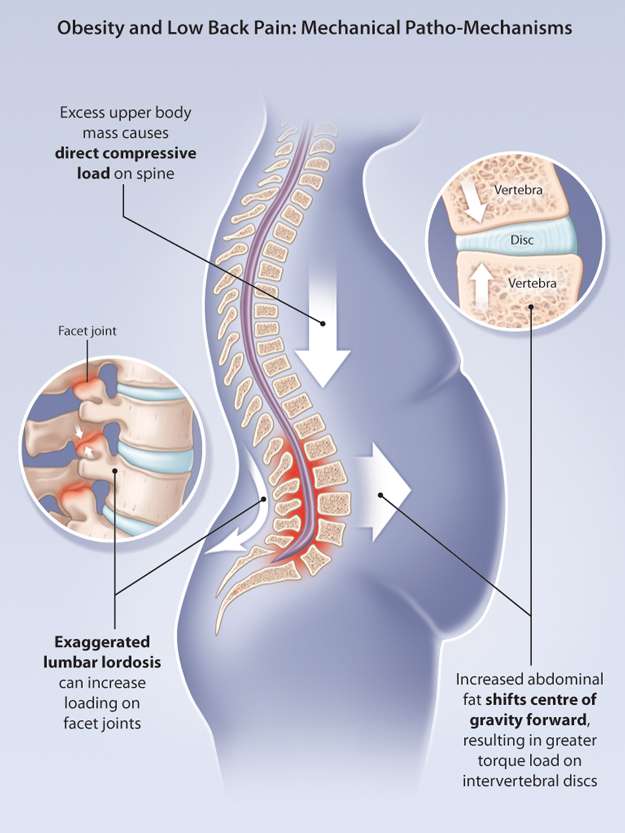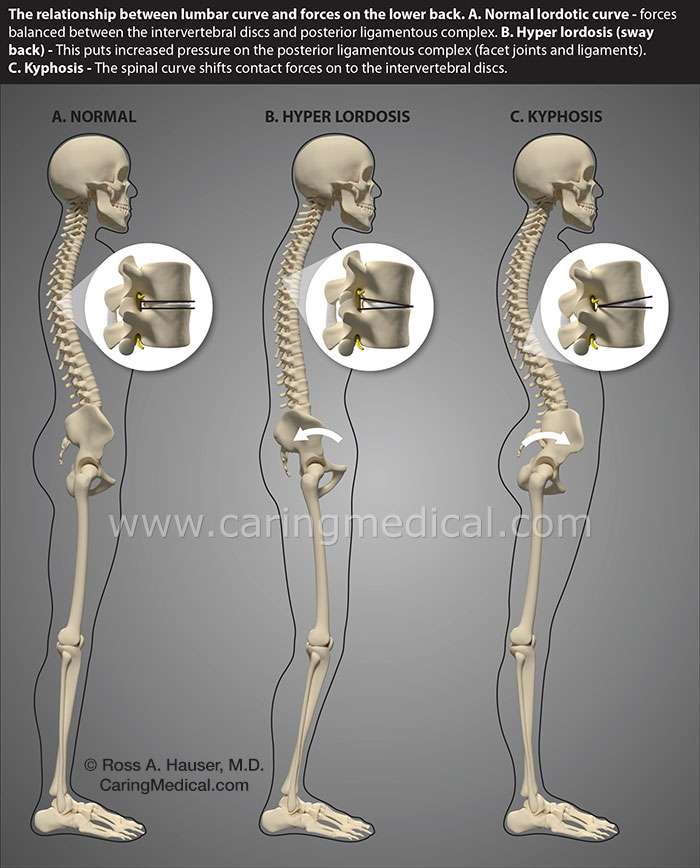So you’ve finally achieved your weight loss goal and shed those extra pounds. Congratulations! But now you’re experiencing an unexpected side effect – back pain. Is this a common consequence of weight loss, or is there something else going on? In this article, we’ll explore the relationship between weight loss and back pain, examining the potential causes and offering some practical tips for finding relief. Whether you’ve recently lost weight or are considering embarking on a weight loss journey, this article will provide valuable insights to help you understand and manage any back pain that may arise.

Causes of Back Pain During Weight Loss
Changes in Posture
During weight loss, your body undergoes significant changes, and these changes can affect your posture. As you lose weight, the distribution of fat and muscle in your body may change, which can lead to shifts in your center of gravity. These shifts can put additional stress on your back, causing pain and discomfort.
Muscle Imbalance
When you engage in weight loss activities such as exercise and dieting, it’s important to maintain a balanced approach. Focusing on specific muscle groups or neglecting certain areas of your body can result in muscle imbalance. This imbalance can strain your back muscles and lead to pain.
Lack of Core Strength
A strong core is essential for maintaining proper posture and supporting your spine. However, during weight loss, many individuals neglect core strengthening exercises in favor of activities that primarily focus on fat burning. This can lead to a lack of core strength, which can contribute to back pain.
Spinal Misalignment
As your body composition changes during weight loss, there is a chance of your spine becoming misaligned. This can occur due to muscle imbalances or changes in your center of gravity. A misaligned spine puts stress on the surrounding muscles and can result in discomfort and back pain.
Joint Stress
Weight loss can put stress on your joints, particularly if you engage in high-impact exercises. The repetitive movements and increased load on your joints can lead to joint inflammation and pain. This can ultimately affect your back, as the spine is connected to various joints in your body.
Preventing Back Pain During Weight Loss
Gradual Weight Loss Approach
To prevent back pain during weight loss, it’s important to adopt a gradual and sustainable approach. Rapid weight loss can put additional stress on your body, including your back. Set realistic goals and aim for a slow and steady rate of weight loss, focusing on overall health and well-being.
Proper Form and Technique
Whether you’re performing strength training exercises, cardio workouts, or practicing yoga, using proper form and technique is crucial. Maintaining proper alignment and engaging the correct muscles will help prevent unnecessary strain on your back. If you’re unsure about proper form, consider working with a trainer or instructor who can guide you.
Balanced Exercise Routine
Incorporating a variety of exercises into your routine is essential for promoting overall strength and balance. Include exercises that target different muscle groups, including your back. This will help prevent muscle imbalances and reduce the risk of back pain. Additionally, alternating between high-impact and low-impact exercises can help minimize joint stress.
Strengthening Core Muscles
To support your spine and maintain good posture, it’s important to prioritize core strengthening exercises. This includes exercises that target your abdominal muscles, back muscles, and the muscles along the sides of your torso. Incorporating exercises such as planks, bridges, and rotational movements can help build core strength and reduce back pain.
Maintaining Good Posture
Maintaining good posture throughout the day is essential for preventing back pain during weight loss. Be mindful of your posture when sitting, standing, and walking. Avoid slouching or hunching your shoulders. Instead, aim to keep your spine aligned and your shoulders relaxed and back. This will help distribute the weight evenly and reduce strain on your back.
Regular Stretching and Flexibility
Stretching plays a key role in maintaining flexibility and preventing muscle tightness. Incorporate regular Stretching exercises into your routine, focusing on both the muscles in your back and the muscles in your legs. This will help improve your overall flexibility and reduce the risk of back pain.
Proper Rest and Recovery
While it’s important to engage in regular exercise, it’s equally important to prioritize rest and recovery. Give your body adequate time to recover between workouts, and listen to your body’s signals. Resting allows your muscles to repair and rebuild, reducing the risk of overuse injuries and back pain.
Using Supportive Equipment
Depending on your weight loss activities, using supportive equipment can be beneficial in preventing back pain. This includes using proper footwear with adequate arch support and cushioning. Additionally, for high-impact activities, consider using equipment such as a supportive sports bra or a weightlifting belt to provide extra support to your back.
Managing Back Pain During Weight Loss
Consulting with a Healthcare Professional
If you experience persistent or severe back pain during weight loss, it’s important to consult with a healthcare professional. They can assess your condition, identify any underlying causes, and provide appropriate treatment recommendations. This may include referring you to a specialist or recommending further diagnostic tests.
Physical Therapy
Physical therapy can be an effective way to manage back pain during weight loss. A physical therapist can work with you to develop a customized exercise program that focuses on strengthening your back muscles, improving flexibility, and promoting proper alignment. They can also provide manual therapy techniques and other modalities to alleviate pain and improve function.
Chiropractic Care
Chiropractic care focuses on the diagnosis and treatment of musculoskeletal conditions, including back pain. A chiropractor can perform spinal adjustments and manipulations to restore proper alignment and relieve pain. They may also recommend exercises, stretches, and lifestyle modifications to support your weight loss goals while minimizing back pain.
Massage Therapy
Massage therapy can provide relief for back pain during weight loss. A skilled massage therapist can target tight muscles, reduce muscle tension, and improve circulation to promote healing. They may use various techniques such as deep tissue massage, trigger point therapy, or myofascial release to address specific areas of pain or discomfort.
Heat and Cold Therapy
Applying heat or cold to your back can help alleviate pain and reduce inflammation. Heat therapy, such as using a heating pad or warm compress, can relax muscles and improve blood flow. Cold therapy, such as applying an ice pack or using a cold gel pack, can numb the area and reduce swelling. Experiment with both to determine which provides the most relief for your back pain.
Over-the-counter Pain Medication
For mild to moderate back pain, over-the-counter pain medication may provide temporary relief. Nonsteroidal anti-inflammatory drugs (NSAIDs) such as ibuprofen or naproxen can help reduce pain and inflammation. However, it’s important to follow the recommended dosage instructions and consult with a healthcare professional if you have any underlying health conditions or are taking other medications.
Alternative Therapies
In addition to conventional treatments, alternative therapies such as acupuncture, yoga, and herbal remedies may offer relief for back pain. Acupuncture involves inserting thin needles into specific points on the body to stimulate healing and reduce pain. Yoga combines physical postures, breathing exercises, and meditation to promote flexibility, strength, and relaxation. Herbal remedies, such as turmeric or ginger, have anti-inflammatory properties that may help alleviate back pain. Always consult with a qualified practitioner before trying any alternative therapy.
Exercises to Support the Back During Weight Loss
Low-Impact Aerobic Exercises
Low-impact aerobic exercises are ideal for supporting your back during weight loss. These exercises are gentle on the joints while still providing cardiovascular benefits. Examples include brisk walking, swimming, cycling, and using an elliptical trainer. They help improve circulation, increase endurance, and burn calories without putting excessive strain on your back.
Strength Training for Back Muscles
Including strength training exercises that specifically target your back muscles is crucial for back support. Exercises such as rows, lat pull-downs, and deadlifts can help strengthen your upper and lower back muscles. It’s important to start with lighter weights and gradually increase as your back muscles become stronger. Remember to use proper form and technique to avoid injury.
Stretching and Yoga Poses
Stretching exercises and yoga poses can promote flexibility and relieve tension in your back muscles. Incorporate stretches that target your back, such as cat-cow stretches, child’s pose, and spinal twists. Practicing yoga can also help improve posture, strengthen core muscles, and reduce stress, all of which contribute to better back health during weight loss.
Pilates and Core Exercises
Pilates exercises focus on core strength, stability, and flexibility. By engaging your deep abdominal muscles, including the transverse abdominis and the pelvic floor, Pilates can help support your back and improve posture. Incorporate exercises such as the plank, side plank, and Pilates roll-ups into your routine to strengthen your core and protect your back.

Maintaining a Healthy Weight and Back Health
Sustainable Weight Loss
Maintaining a healthy weight is crucial for overall back health. It’s important to adopt sustainable weight loss practices that focus on long-term success rather than quick fixes. Aim to lose weight gradually and consistently, with a focus on making sustainable lifestyle changes such as adopting a healthy and balanced diet, increasing physical activity, and managing stress.
Achieving and Maintaining BMI
Body mass index (BMI) is a measurement that estimates your body fat based on your height and weight. Achieving and maintaining a healthy BMI is an important factor in promoting back health. Work with a healthcare professional or registered dietitian to determine your target BMI and develop a plan to achieve it through a combination of diet, exercise, and lifestyle changes.
Healthy Eating Habits
Adopting healthy eating habits is essential for maintaining a healthy weight and supporting back health. Focus on consuming a balanced diet that includes a variety of fruits, vegetables, whole grains, lean proteins, and healthy fats. Limit processed foods, sugary beverages, and excessive salt intake, as these can contribute to inflammation and weight gain, which can impact back health.
Regular Physical Activity
Engaging in regular physical activity is crucial for both weight management and back health. Aim for at least 150 minutes of moderate-intensity aerobic activity per week, along with muscle-strengthening exercises at least twice a week. This will help burn calories, build strength, and promote overall back health.
Maintaining Good Posture
Maintaining good posture is important not only during weight loss but also in daily life. Practice proper posture when sitting, standing, and walking. Avoid slouching or hunching your shoulders and aim to keep your spine aligned. Use ergonomic chairs and supportive pillows if necessary to maintain good posture throughout the day.
Avoiding Sedentary Lifestyle
Prolonged periods of sitting can contribute to back pain and other health issues. Avoid a sedentary lifestyle by incorporating movement throughout your day. Take regular breaks to stretch and walk, use a standing desk if possible, and find opportunities to be physically active, such as taking the stairs instead of the elevator or going for short walks during your breaks.
Stress Management
Stress can exacerbate back pain and contribute to weight gain. Incorporate stress management techniques into your daily routine, such as meditation, deep breathing exercises, and engaging in activities that bring you joy and relaxation. Prioritizing self-care and finding healthy ways to cope with stress can help protect your back and promote overall well-being.
Improving Sleep Quality
Quality sleep is essential for overall health, including back health. Develop a bedtime routine that promotes relaxation and good sleep hygiene. Ensure you have a comfortable mattress and pillow that adequately support your back. If you have trouble sleeping or experience back pain while sleeping, consult with a healthcare professional for further evaluation and recommendations.
When to Seek Medical Attention
Severe or Chronic Back Pain
If you experience severe or chronic back pain that persists for more than a few weeks, it’s important to seek medical attention. Severe pain may indicate an underlying condition that requires further evaluation and treatment.
Radiating Pain or Numbness
If you experience radiating pain or numbness that travels down your leg or arms, it could be a sign of nerve compression or damage. This should be evaluated by a healthcare professional to prevent further complications.
Loss of Bowel or Bladder Control
Loss of bowel or bladder control, along with back pain, can be a sign of a serious condition such as cauda equina syndrome. This is a medical emergency and requires immediate medical attention.
Persistent Pain despite Rest and Home Remedies
If you’ve tried rest, home remedies, and over-the-counter pain medication but are still experiencing persistent pain, it’s important to consult with a healthcare professional. They can evaluate your condition and provide appropriate treatment options.
Other Symptoms or Health Concerns
If you experience any other symptoms or health concerns along with your back pain, such as unexplained weight loss, fever, or changes in bowel or bladder habits, it’s important to seek medical attention. These symptoms may be unrelated to your weight loss and could indicate an underlying medical condition that needs to be addressed.

Conclusion
While back pain can occur during weight loss, there are various causes, preventive measures, management techniques, and exercises that can help alleviate and prevent it. Maintaining good posture, engaging in regular exercise that targets the back muscles, and adopting a gradual weight loss approach are essential for back health. Additionally, seeking professional help when needed and prioritizing overall well-being contribute to a healthy and pain-free weight loss journey. Remember to listen to your body, make necessary adjustments, and celebrate the progress you make towards a healthier lifestyle.
